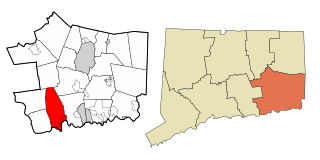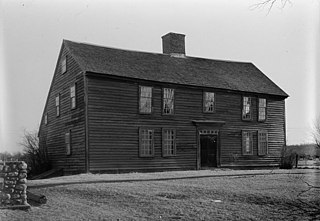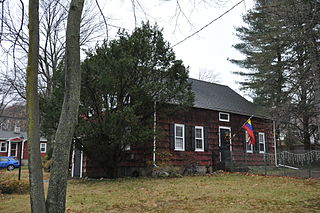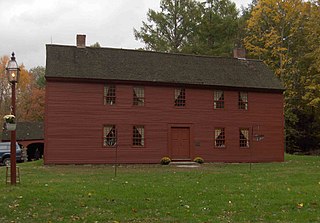
East Lyme is a town in New London County, Connecticut, United States. The population was 18,693 at the 2020 census. The villages of Niantic and Flanders are located in the town.

The Smith–Harris House, listed on the National Register of Historic Places as the Thomas Avery House, is a 2+1⁄2-story clapboarded Greek Revival home on Society Road in East Lyme, Connecticut. It is believed that the farmhouse was built in 1845–1846 as a wedding gift for Thomas Avery and Elizabeth Griswold. It remained in the Avery family until 1877, when it was purchased by William H. Smith. By the 1890s, the farm was managed by Smith's younger brother, Herman W. Smith, and nephew, Frank A. Harris. In 1900, the two married Lula and Florence Munger, sisters, and both resided in the house. In 1955, the house was sold to the Town of East Lyme, and the sisters continued to live in the house until requiring a nursing home. The house was saved from demolition by citizens and restored. It opened on July 3, 1976, as a historic house museum, operated and maintained by the Smith–Harris House Commission and the Friends of Smith–Harris House. It is open from June through August and throughout the year by appointment. The Smith–Harris house was added to the National Historic Register of Places on August 22, 1979.

The Thomas Lee House is a historic house at the junction of Giant's Neck Road and Connecticut Route 156 in the Niantic section of East Lyme, Connecticut. Built about 1660, it is one of the oldest wood-frame houses in Connecticut. Restored in the early 20th century by Norman Isham, it is now maintained by the East Lyme Historical Society as a museum. It was listed on the National Register of Historic Places in 1970.

The Eells-Stow House is operated as a historic house museum at 34 High Street in Milford, Connecticut. Built as a private residence and with a construction history dating to c. 1700, it is believed to be Milford's oldest surviving building. It has a complex history of later additions and alterations. It was listed on the National Register of Historic Places in 1977. It is now owned by the Milford Historical Society.

The Clark Homestead is a historic house on Madley Road in Lebanon, Connecticut. Built c. 1708, it is believed to be Lebanon's oldest building. It was owned in the late 18th century by James Clark, a veteran of the American Revolutionary War. The house was listed on the National Register of Historic Places on December 1, 1978.

The Samuel Ferris House is a historic house at 1 Cary Street in Greenwich, Connecticut. Built around 1760 and enlarged around 1800, it is a well-preserved example of a Colonial period Cape, a rare survivor of the form to still stand facing the Boston Post Road in the town. It is also locally significant for its connections to the Ferris family, early settlers of the area. The house was listed on the U.S. National Register of Historic Places in 1989.

The John Glover House is a historic house at 53 Echo Valley Road in Newtown, Connecticut. Built about 1708 by an early town settler, it is a remarkably well-preserved example of 18th-century residential architecture, owned for generations by a locally prominent farming family. The house was listed on the National Register of Historic Places in 2001.

The Captain Enoch Lord House, also known as Red House, is a historic house at 17 Tantummaheag Road in Old Lyme, Connecticut. Built about 1748, the house is significant both for its long historic association with the colonial Lord family, who were influential participants in the founding of both the Connecticut Colony and the Saybrook Colony, and for its transformation in the late 19th century into a summer estate. The house was listed on the National Register of Historic Places in 2007.

The Strong House, now the Strong-Porter Museum, is a historic house museum at 2382 South Street in Coventry, Connecticut. It is a 2+1⁄2-story wood-frame structure, five bays wide, with a center entry and two interior chimneys. The oldest portion of the house is estimated to date to 1710, early in the period of Coventry's settlement, and retains a significant number of period features. The house was listed on the National Register of Historic Places in 1988. It is now owned and operated by the Coventry Historical Society as a museum. In addition to exhibits in the house about local history, visitors can tour the carpenter shop, 19th century privy, carriage sheds and barn.

The Jedidiah Dudley House, is a historic house on Springbrook Road in Old Saybrook, Connecticut. Built in the second half of the 18th century, it is a good example of period architecture, and is notable for its association with a family of ferry operators on the nearby Connecticut River. It was listed on the National Register of Historic Places in 1982.

The Moses Kent House is a historic house on River Road in Lyme, New Hampshire. Built in 1811, it is a good local example of Federal period architecture, most notable for the well-preserved murals on its interior walls, drawn by the itinerant artist Rufus Porter. The house was listed on the National Register of Historic Places in 1984.

The Killicut-Way House is a historic house at 2 Old House Lane in Nashua, New Hampshire. Estimated to have been built c. 1740, this 1+1⁄2-story Cape style house is one of the oldest buildings in Nashua, and one of a small number of houses from that period in the region that is relatively unaltered. The house was listed on the National Register of Historic Places in 1989.

The Francis Benedict Jr. House, or Benedict–Smith House, is a historic house at 85 North Colebrook Road in Norfolk, Connecticut. Erected sometime between about 1795 and 1811, it is a high-quality example of late Colonial and early Federal architecture, and a well-preserved surviving example of the town's early architecture. It was listed on the National Register of Historic Places in 2002.
The Samuel Forbes Homestead is a historic house at 89 Lower Road in North Canaan, Connecticut. Built about 1754, with a number of significant alterations over time, it is significant as the home of Samuel Forbes, a major figure in the 18th-century development of the iron foundries in northwestern Connecticut. The house was listed on the National Register of Historic Places in 1992.

The Caleb Martin House is a historic house at 42 Mill Pond Road in Bethlehem, Connecticut. With its oldest portion dating to 1730, it is one of the community's oldest buildings, exhibiting a wealth of construction detail through its 18th-century transformation from a small single-pile house to a full saltbox. It was listed on the National Register of Historic Places in 1996.
The Abraham Coult House is a historic house at 1695 Hebron Avenue in Glastonbury, Connecticut. Built about 1706 and enlarged several times, it is a well-preserved colonial residence, exhibiting changing construction methods through its alterations. Moved in the 1970s to avoid demolition and restored, it was listed on the National Register of Historic Places in 2000.

The Gridley-Parson-Staples House is a historic house museum at 1554 Farmington Avenue in Farmington, Connecticut. Probably built about 1760, it is the oldest surviving house in northwestern Farmington, and a fine example of 18th century Georgian architecture. It is now home to the Farmington Historical Society, and was listed on the National Register of Historic Places in 1981.

The Capt. Thomas Fanning Farmstead is a historic farm property at 1004 Shewville Road in Ledyard, Connecticut. With a building history dating to about 1746, it is one of the oldest surviving agricultural properties in the town, including the house, barn, and smaller outbuildings. The property, now reduced to 4 acres (1.6 ha), was listed on the National Register of Historic Places in 1992.

The Plaster House is a historic house at 117 Plaster House Road in Southbury, Connecticut. Probably built in the mid-18th century, it is an extremely rare example of 18th-century stone residential construction in the state. The small structure may have originally been built as a farm outbuilding by a member of locally prominent Hinman family. It was listed on the National Register of Historic Places in 1993.

The Shelley House is a historic house at 248 Boston Post Road in Madison, Connecticut. Probably built in the late 17th century and enlarged in the 18th century, this house's architecture clearly exhibits a typical growth pattern of colonial-era houses from a one-room stone ender to a saltbox house. The house was listed on the National Register of Historic Places in 1989.




















